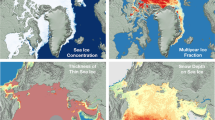Abstract
The infrared imager onboard the Geostationary Operational Environmental Satellite 15 (GOES-15) provides temporally continuous observations over a limited spatial domain. To quantify bias of the GOES-15 imager, observations from four infrared channels (2, 3, 4, and 6) are compared with simulations from the numerical weather prediction model and radiative transfer model. One-day clear-sky infrared observations from the GOES-15 imager over an oceanic domain during nighttime are selected. Two datasets, Global Forecast System (GFS) analysis and ERAInterim reanalysis, are used as inputs to the radiative transfer model. The results show that magnitudes of biases for the GOES-15 surface channels are approximately 1 K using two datasets, whereas the magnitude of bias for the GOES-15 water vapor channel can reach 5.5 K using the GFS dataset and 2.5 K using the ERA dataset. The GOES- 15 surface channels show positive dependencies on scene temperature, whereas the water vapor channel has a weak dependence on scene temperature. The strong dependence of bias on sensor zenith angle for the GOES-15 water vapor channel using GFS analysis implies large biases might exist in GFS water vapor profiles.
Similar content being viewed by others
References
Auligné T, McNally A P, Dee D P (2007). Adaptive bias correction for satellite data in a numerical weather prediction system. Q J R Meteorol Soc, 133(624): 631–642
Capderou M (2005). Satellites: Orbits and Missions. Berlin: Springer, 364
Chen Y, Han Y, van Delst P, Weng F (2013). Assessment of shortwave infrared sea surface reflection and nonlocal thermodynamic equilibrium effects in the community radiative transfer model using IASI data. J Atmos Ocean Technol, 30(9): 2152–2160
Cox C, Munk W (1954). Measurements of the roughness of the sea surface from photographs of the sun’s glitter. J Opt Soc Am, 44(11): 838–850
Da C (2015). Preliminary Assessment of the Advanced Himawari Imager (AHI) Measurement onboard Himawari-8 Geostationary Satellite. Remote Sens Lett, 6(8): 637–646
Da C, Zou X (2014). An introduction to GOES imager data. Advances in Met S&T, doi: 10.3969/j.issn.2095-1973.2014.04.009
Dee D P (2005). Bias and data assimilation. Q J R Meteorol Soc, 131 (613): 3323–3343
Han Y, Weng F, Liu Q, van Delst P (2007). A fast radiative transfer model for SSMIS upper atmosphere sounding channels. J Geophys Res, 112(D11): 121
Hewison T J, Wu X, Yu F, Tahara Y, Hu X, Kim D, Koenig M (2013). GSICS inter-calibration of infrared channels of geostationary imagers using Metop/IASI. IEEE Trans Geosci Rem Sens, 51(3): 1160–1170
Köpken C, Kelly G, Thépaut J N (2004). Assimilation of meteosat radiance data within the 4D-var system at ECMWF: assimilation experiments and forecast impact. Q J R Meteorol Soc, 130(601): 2277–2292
Menzel P, Schmetz J, Nieman S, van de Berg L, Gaertner V, Schmit T (1993). Intercomparison of the Operational Calibration of GOES-7 and Meteosat-3/4. US Department of Commerce, National Oceanic and Atmospheric Administration, National Environmental Satellite, Data, and Information Service
Qin Z, Zou X, Weng F (2013). Evaluating added benefits of assimilating GOES imager radiance data in GSI for coastal QPFs. Mon Weather Rev, 141(1): 75–92
Schmit T, Gunshor M, Fu G, Rink T, Bah K (2012). GOES-R Advanced Baseline Imager (ABI) algorithm theoretical basis document for cloud and moisture imagery product (CMIP), Version 3.0
Su X, Derber J C, Jung J A, Tahara Y (2003). The usage of GOES imager clear sky brightness temperatures in the NCEP global data assimilation system. Preprints, 12th Conf. On Satellite Meteorology and Oceanography, Long Beach, CA, American Meteorological Society
Szyndel M D E, Kelly G, Thépaut J N (2005). Evaluation of potential benefit of assimilation of SEVIRI water vapour radiance data from Meteosat-8 into global numerical weather prediction analyses. Atmos Sci Lett, 6(2): 105–111
Weinreb M, Jamieson M, Fulton N, Chen Y, Johnson J X, Bremer J, Smith C, Baucom J (1997). Operational calibration of geostationary operational environmental Satellite-8 and -9 imagers and sounders. Appl Opt, 36(27): 6895–6904
Author information
Authors and Affiliations
Corresponding author
Rights and permissions
About this article
Cite this article
Ren, L. A case study of GOES-15 imager bias characterization with a numerical weather prediction model. Front. Earth Sci. 10, 409–418 (2016). https://doi.org/10.1007/s11707-016-0579-y
Received:
Accepted:
Published:
Issue Date:
DOI: https://doi.org/10.1007/s11707-016-0579-y




